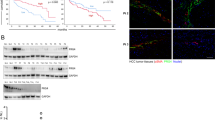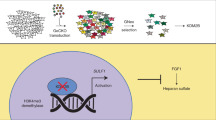Abstract
Heparan sulfate proteoglycans are integral components of the extracellular matrix that surrounds all mammalian cells. In addition to providing structural integrity, they act as a storage depot for a variety of heparan sulfate (HS)-binding proteins, including growth factors and chemokines. Heparanase is a matrix-degrading enzyme that cleaves heparan sulfate side chains from the core proteoglycans, thus liberating such HS-binding proteins, as well as potentially contributing to extracellular matrix degradation. Here, we report that heparanase mRNA and protein expression are increased in the neoplastic stages progressively unfolding in a mouse model of multistage pancreatic islet carcinogenesis. Notably, heparanase is delivered to the neoplastic lesions in large part by infiltrating Gr1+/Mac1+ innate immune cells. A sulfated oligosaccharide mimetic of heparan sulfate, PI-88, was used to inhibit simultaneously both heparanase activity and HS effector functions. PI-88 had significant effects at distinct stages of tumorigenesis, producing a reduction in the number of early progenitor lesions and an impairment of tumor growth at later stages. These responses were associated with decreased cell proliferation, increased apoptosis, impaired angiogenesis, and a substantive reduction in the number of invasive carcinomas. In addition, we show that the reduction in tumor angiogenesis is correlated with a reduced association of VEGF-A with its receptor VEGF-R2 on the tumor endothelium, implicating heparanase in the mobilization of matrix-associated VEGF. These data encourage clinical applications of inhibitors such as PI-88 for the many human cancers where heparanase expression is elevated or mobilization of HS-binding regulatory factors is implicated.
This is a preview of subscription content, access via your institution
Access options
Subscribe to this journal
Receive 50 print issues and online access
$259.00 per year
only $5.18 per issue
Buy this article
- Purchase on Springer Link
- Instant access to full article PDF
Prices may be subject to local taxes which are calculated during checkout







Similar content being viewed by others
References
Bartlett MR, Cowden WB and Parish CR . (1995). J. Leukoc. Biol., 57, 207–213.
Bergers G, Brekken R, McMahon G, Vu TH, Itoh T, Tamaki K, Tanzawa K, Thorpe P, Itohara S, Werb Z and Hanahan D . (2000). Nat. Cell Biol., 2, 737–744.
Bergers G, Javaherian K, Lo KM, Folkman J and Hanahan D . (1999). Science, 284, 808–812.
Bergers G, Song S, Meyer-Morse N, Bergsland E and Hanahan D . (2003). J. Clin. Invest., 111, 1287–1295.
Bernfield M, Gotte M, Park PW, Reizes O, Fitzgerald ML, Lincecum J and Zako M . (1999). Annu. Rev. Biochem., 68, 729–777.
Brekken RA, Huang X, King SW and Thorpe PE . (1998). Cancer Res., 58, 1952–1959.
Cochran S, Li C, Fairweather JK, Kett WC, Coombe DR and Ferro V . (2003). J. Med. Chem., 46, 4601–4608.
Compagni A, Wilgenbus P, Impagnatiello MA, Cotten M and Christofori G . (2000). Cancer Res., 60, 7163–7169.
D'Amore MA, Gallagher PM, Korfhagen TR and Ganschow RE . (1988). Biochemistry, 27, 7131–7140.
Dempsey LA, Plummer TB, Coombes SL and Platt JL . (2000). Glycobiology, 10, 467–475.
Efrat S, Linde S, Kofod H, Spector D, Delannoy M, Grant S, Hanahan D and Baekkeskov S . (1988). Proc. Natl. Acad. Sci. USA, 85, 9037–9041.
Elson DA, Thurston G, Huang LE, Ginzinger DG, McDonald DM, Johnson RS and Arbeit JM . (2001). Genes Dev., 15, 2520–2532.
Ferro V, Fewings K, Palermo MC and Li C . (2001). Carbohydrate Res., 332, 183–189.
Folkman J, Watson K, Ingber D and Hanahan D . (1989). Nature, 339, 58–61.
Francis DJ, Parish CR, McGarry M, Santiago FS, Lowe HC, Brown KJ, Bingley JA, Hayward IP, Cowden WB, Campbell JH, Campbell GR, Chesterman CN and Khachigian LM . (2003). Circ. Res., 92, e70–e77.
Freeman C and Parish CR . (1997). Biochem. J., 325 (Part 1), 229–237.
Freeman C and Parish CR . (1998). Biochem. J., 330 (Part 3), 1341–1350.
Friedmann Y, Vlodavsky I, Aingorn H, Aviv A, Peretz T, Pecker I and Pappo O . (2000). Am. J. Pathol., 157, 1167–1175.
Giraudo E, Inoue M and Hanahan D . (2004). J. Clin. Invest., 114, 623–633.
Goldshmidt O, Zcharia E, Abramovitch R, Metzger S, Aingorn H, Friedmann Y, Schirrmacher V, Mitrani E and Vlodavsky I . (2002). Proc. Natl. Acad. Sci. USA, 99, 10031–10036.
Haimov-Kochman R, Friedmann Y, Prus D, Goldman-Wohl DS, Greenfield C, Anteby EY, Aviv A, Vlodavsky I and Yagel S . (2002). Mol. Hum. Reprod., 8, 566–573.
Hanahan D . (1985). Nature, 315, 115–122.
Hileman RE, Fromm JR, Weiler JM and Linhardt RJ . (1998). BioEssays, 20, 156–167.
Hulett MD, Freeman C, Hamdorf BJ, Baker RT, Harris MJ and Parish CR . (1999). Nat. Med., 5, 803–809.
Inoue M, Hager JH, Ferrara N, Gerber HP and Hanahan D . (2002). Cancer Cell., 1, 193–202.
Iozzo RV and San Antonio JD . (2001). J. Clin. Invest., 108, 349–355.
Ishai-Michaeli R, Eldor A and Vlodavsky I . (1990). Cell Regul., 1, 833–842.
Joyce JA, Baruch A, Chehade K, Meyer-Morse N, Giraudo E, Tsai FY, Greenbaum DC, Hager JH, Bogyo M and Hanahan D . (2004). Cancer Cell., 5, 443–453.
Kalluri R . (2003). Nat. Rev. Cancer, 3, 422–433.
Kelly T, Miao HQ, Yang Y, Navarro E, Kussie P, Huang Y, MacLeod V, Casciano J, Joseph L, Zhan F, Zangari M, Barlogie B, Shaughnessy J and Sanderson RD . (2003). Cancer Res., 63, 8749–8756.
Khachigian LM and Parish CR . (2004). Cardiovasc. Drug Rev., 22, 1–6.
Kim AW, Xu X, Hollinger EF, Gattuso P, Godellas CV and Prinz RA . (2002). J. Gastrointest. Surg., 6, 167–172.
Koliopanos A, Friess H, Kleeff J, Shi X, Liao Q, Pecker I, Vlodavsky I, Zimmermann A and Buchler MW . (2001). Cancer Res., 61, 4655–4659.
Levidiotis V, Freeman C, Tikellis C, Cooper ME and Power DA . (2004). J. Am. Soc. Nephrol., 15, 68–78.
Lopez T and Hanahan D . (2002). Cancer Cell, 1, 339–353.
Marchetti D, Li J and Shen R . (2000). Cancer Res., 60, 4767–4770.
Marchetti D and Nicolson GL . (1997). Adv. Enzyme. Regul., 37, 111–134.
Maxhimer JB, Quiros RM, Stewart R, Dowlatshahi K, Gattuso P, Fan M, Prinz RA and Xu X . (2002). Surgery, 132, 326–333.
Nakajima M, Irimura T and Nicolson GL . (1988). J. Cell. Biochem., 36, 157–167.
Ornitz DM . (2000). BioEssays, 22, 108–112.
Parangi S, Dietrich W, Christofori G, Lander ES and Hanahan D . (1995). Cancer Res., 55, 6071–6076.
Parish CR, Freeman C, Brown KJ, Francis DJ and Cowden WB . (1999). Cancer Res., 59, 3433–3441.
Parish CR, Freeman C and Hulett MD . (2001). Biochim. Biophys. Acta, 1471, M99–M108.
Powers CJ, McLeskey SW and Wellstein A . (2000). Endocr. Relat. Cancer, 7, 165–197.
Rodriguez-Manzaneque JC, Lane TF, Ortega MA, Hynes RO, Lawler J and Iruela-Arispe ML . (2001). Proc. Natl. Acad. Sci. USA, 98, 12485–12490.
Schlessinger J, Plotnikov AN, Ibrahimi OA, Eliseenkova AV, Yeh BK, Yayon A, Linhardt RJ and Mohammadi M . (2000). Mol. Cell, 6, 743–750.
Soker S, Goldstaub D, Svahn CM, Vlodavsky I, Levi BZ and Neufeld G . (1994). Biochem. Biophys. Res. Commun., 203, 1339–1347.
Tang W, Nakamura Y, Tsujimoto M, Sato M, Wang X, Kurozumi K, Nakahara M, Nakao K, Nakamura M, Mori I and Kakudo K . (2002). Mod. Pathol., 15, 593–598.
Tumova S, Woods A and Couchman JR . (2000). Int. J. Biochem. Cell Biol., 32, 269–288.
Uno F, Fujiwara T, Takata Y, Ohtani S, Katsuda K, Takaoka M, Ohkawa T, Naomoto Y, Nakajima M and Tanaka N . (2001). Cancer Res., 61, 7855–7860.
Vlodavsky I, Bar-Shavit R, Ishai-Michaeli R, Bashkin P and Fuks Z . (1991). Trends Biochem. Sci., 16, 268–271.
Vlodavsky I, Friedmann Y, Elkin M, Aingorn H, Atzmon R, Ishai-Michaeli R, Bitan M, Pappo O, Peretz T, Michal I, Spector L and Pecker I . (1999). Nat. Med., 5, 793–802.
Vlodavsky I, Miao HQ, Medalion B, Danagher P and Ron D . (1996). Cancer Metast. Rev., 15, 177–186.
Yurchenco PD and Schittny JC . (1990). FASEB J., 4, 1577–1590.
Zcharia E, Metzger S, Chajek-Shaul T, Friedmann Y, Pappo O, Aviv A, Elkin M, Pecker I, Peretz T and Vlodavsky I . (2001). J. Mammary Gland Biol. Neoplasia, 6, 311–322.
Zetser A, Bashenko Y, Miao HQ, Vlodavsky I and Ilan N . (2003). Cancer Res., 63, 7733–7741.
Acknowledgements
We thank Progen Industries, Australia, for supplying PI-88, and B Creese and D Podger, Progen, Australia, for helpful advice. We thank C Concengco and E Solliven for excellent technical assistance, and D Ginzinger and M Yu, UCSF Cancer Center Genome Facility, for Taqman analysis. We are grateful to K Butterfield and J Folkman, Harvard Medical School, MA, USA, for providing primary bovine endothelial cells, and R Brekken, Hope Heart Institute, WA, USA, for providing the GV39M antibody. We thank Z Werb and O Stevaux for insightful review of the manuscript. JAJ is a Fellow of the Leukemia and Lymphoma Society. This work was supported by the William K Bowes Jr Foundation, the American Cancer Society, and the US National Cancer Institute (DH). CF and CRP are recipients of an Australian National Health and Medical Research Council Program grant.
Author information
Authors and Affiliations
Corresponding authors
Rights and permissions
About this article
Cite this article
Joyce, J., Freeman, C., Meyer-Morse, N. et al. A functional heparan sulfate mimetic implicates both heparanase and heparan sulfate in tumor angiogenesis and invasion in a mouse model of multistage cancer. Oncogene 24, 4037–4051 (2005). https://doi.org/10.1038/sj.onc.1208602
Received:
Revised:
Accepted:
Published:
Issue Date:
DOI: https://doi.org/10.1038/sj.onc.1208602
Keywords
This article is cited by
-
Heparanase: a potential marker of worse prognosis in estrogen receptor-positive breast cancer
npj Breast Cancer (2021)
-
Adjuvant treatment strategy after curative resection for hepatocellular carcinoma
Frontiers of Medicine (2021)
-
Heparanase and the hallmarks of cancer
Journal of Translational Medicine (2020)
-
Emerging enzymatic targets controlling angiogenesis in cancer: preclinical evidence and potential clinical applications
Medical Oncology (2018)
-
HSV-1 interaction to 3-O-sulfated heparan sulfate in mouse-derived DRG explant and profiles of inflammatory markers during virus infection
Journal of NeuroVirology (2017)



